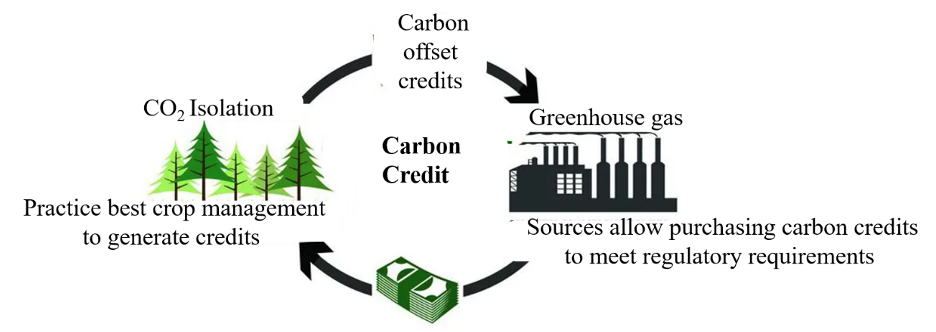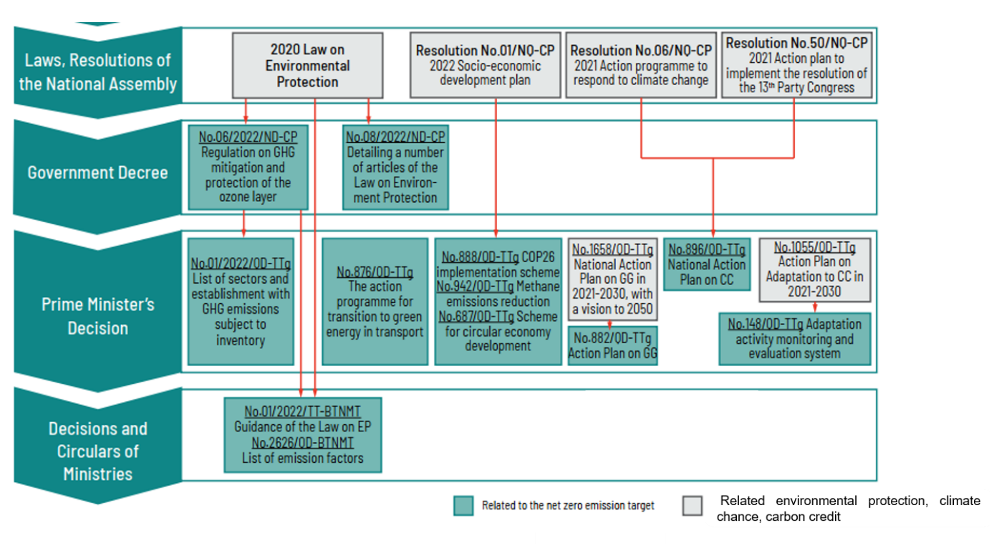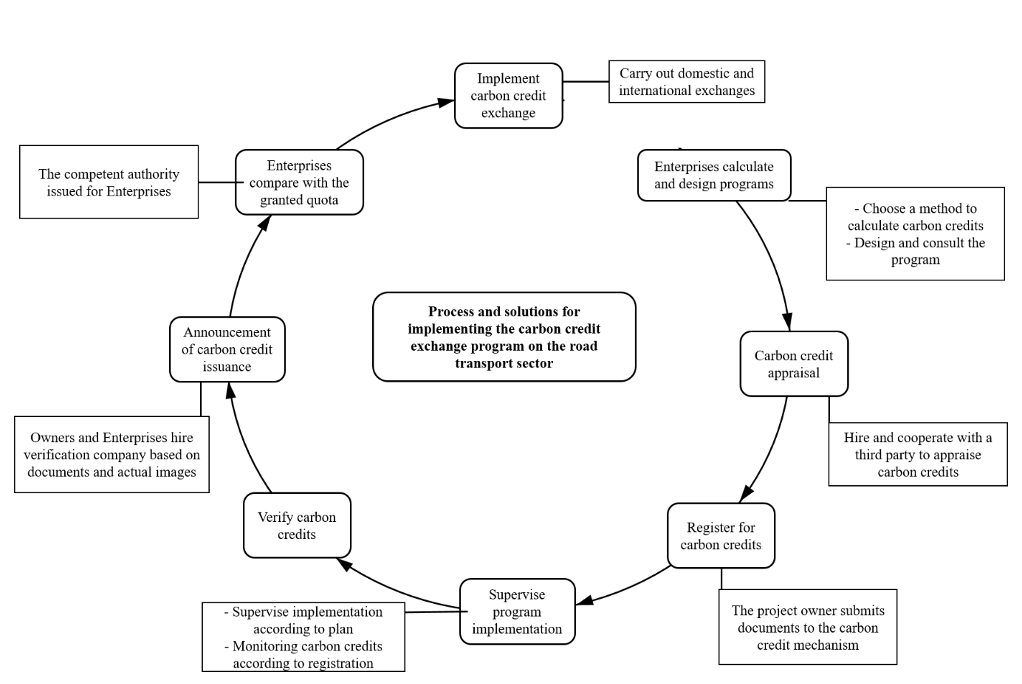

01/08/2024
1. Introduction
In Vietnam, the activities of the transport sector in general and road transport services in particular contribute significantly to economic growth and quality of life. The gross domestic product (GDP) of transport and warehousing activities has increased in recent years and reached 5.4% of the country's total GDP in 2022. Due to, demand for passenger and cargo transport increased with the average annual increase of 2.9% and 10.2% in the period of 2015-2022, respectively. The road sector accounts for a large proportion of transport with 91.8% of total passenger volume and 79.8% of total cargo volume by 2022 (General Statistics Office, 2023). Fuel used for vehicles is mainly gasoline and diesel. Vehicles used in this sector are very diverse including motorbikes, cars (taxi), buses, passenger cars, trucks (light, medium and heavy).
Besides making an important contribution to economic growth, the energy consumption demand of the transport sector also accounts for a significant proportion. Only considering transport service activities, total energy consumption ranked third in the economy. In 2000, the energy consumption was 830.9 ktoe (1.7 times higher than in 1996); followed by 2,633.1 ktoe in 2007 (3.2 times higher than in 2000); it was 4,883.3 ktoe in 2012 (1.85 times more than in 2007) and in 2018 it was 9,733.5 ktoe (2 times more than in 2012). The average annual growth rate is approximately 14.5% in the period of 1996 - 2018. The main fuels used in the transport sector are gasoline and diesel, accounting for 99% in the past 22 years.
In the transport service sector, road transport services play an important role and consume the largest amount of energy. The energy consumption of the road transport sector was 48.2% (equivalent to 238.2 ktoe) in 1996; 29.7% (equivalent to 247.2 ktoe) in 2000; 62.2% (equivalent to 1,637.1 ktoe) in 2007; 58.4% (equivalent to 2,851.4 ktoe) in 2012 and 60.0% (equivalent to 5,836.8 ktoe) in 2018 (Pham Thi Hue, 2021). If mitigation solutions are not applied, this emission rate will increase to 71% by 2040 (World Bank, 2013).
Due to CO2 emissions content in the road sector is the highest, so Vietnam needs to apply greenhouse gas (GHG) emissions reduction solutions. At the same time, Vietnam will soon build processes, roadmaps and solutions for the carbon credit market development to achieve the goal of bringing net emissions to “zero” by 2050 and improving the economic efficiency of the sector.
2. Concept of carbon credit market
The carbon credit market originated from the United Nations Kyoto Protocol on Climate Change, adopted in 1997. According to this organization, surplus countries have the rights in order to sold or purchased them from countries. Since then, a new type of commodity has appeared widely in the world, namely GHG emission reduction/absorption certificates, transactions collectively known as carbon trading and exchange, forming a carbon market (Figure 1).

Figure 1. Carbon credit market model
Source: Pham Hong Quan, 2023.
The carbon market has developed strongly in European, American and Asian countries with two main types of markets such as mandatory carbon markets and voluntary carbon markets. In particular, the mandatory carbon market is a market in which carbon trading is based on the commitments of countries in the United Nations Framework Convention on Climate Change (UNFCCC) to achieve GHG reduction goals. The voluntary carbon market is a market based on bilateral or multilateral cooperation agreements between organizations, companies or countries. Credit purchasers engage in transactions on a voluntary basis to meet environmental, social and corporate governance (ESG) policies to reduce their carbon footprint.
The market price of carbon credits in each country is very different: In 2022, the price of one carbon credit was 9.29 USD/ton in China while it is 87 USD/ton in Europe as well as 40 USD/ton in Australia. Meanwhile, the market prices have been fluctuated sharply, from the lowest of 15 USD/ton to the highest of 96 USD/ton at Europe since 2020. Carbon pricing is an approach to effectively reduce GHG emissions through the use of market mechanisms to transfer the costs of emissions to emission sources according to the “polluter pays” principle”. Accordingly, emission facilities must be responsible for paying the costs due to releasing GHG into the atmosphere (Pham Hong Quan, 2023).
3. Opportunities and challenges for developing carbon markets for Vietnam's road transport sector
* About opportunities: The road transport sector plays an important role in implementing national GHG emission reduction goals and achieving climate goals. Because through a circular, sustainable and low-carbon production and business model, this field will directly contribute to reducing GHG emissions, towards green production - consumption and emissions goals. net is “0”. According to the Nationally Determined Contribution Report 2020 (NDC, 2020), updated NDC 2022 (NDC, 2022) Vietnam has increased its unconditional emission reduction contribution to 2030 from 9% to 15.8%. and conditional contributions from 27% to 43.5%. To achieve the above goals, in recent years, the transport sector has proposed and implemented a Strategy for efficient use of energy, which focuses on 4 main groups of solutions for the road transport sector, including energy efficiency (limiting fuel consumption for motorbikes and cars; improving road vehicle emission standards; increasing truck load factors); converting from private to public means (developing the regular bus system, developing the rapid bus system, developing the metro system); conversion from road transport to waterway and rail (conversion from road to inland waterway, conversion from road transport to coastal transport, conversion from road to rail); fuel/energy conversion for the vehicle fleet (promoting the use of biofuel, using electric motorbikes, electric cars, electric buses, electric trucks) (GIZ and UNDP, 2022).
In addition, legal documents on GHG emission reduction and carbon credit market issued by Vietnam are the legal basis for road transport enterprises to implement, specifically: In Article 139, The Law on Environmental Protection 2020 stipulates the organization and development of the domestic carbon credit market, in which the Agency is tasked with setting the total quota and determining the quota allocation method to be applied in the carbon credit exchange system (ETS) is the Ministry of Natural Resources and Environment. On that basis, on January 7th, 2022, the Government continued to issue Decree 06/2022/ND-CP detailing the mitigation of GHG emissions, protecting the ozone layer, as well as specifying carbon credit market. The Decree also stipulates that the carbon credit exchange will be established and tested from 2025 and officially put into operation in 2028; Decision No.01/2022/QD-TTg promulgating a list of GHG-emitting sectors and facilities that must conduct GHG inventories; Circular No.01/2022/TT-BTNMT details the implementation of the Law on Environmental Protection in response to climate change.
Along with that, the Government also issued Decision No. 876/QD-TTg dated July 22th, 2022 on approving the Action Program on green energy conversion and reducing carbon and methane emissions for the transport sector (Figure 2). Currently, amount of 70 per 1,912 enterprises in the road transport sector are required to inventory and report their GHG emissions inventory. However, the inspection and examination will be carried out regularly to provide information to the related ministries. Participating in the carbon market not only contributes to improving reputation but also performs well the task of environmental protection.

Figure 2. Diagram of the current legal document system related to GHG emission reduction in the road transport sector (GIZ, 2023)
* Some challenges: The Vietnam Energy Outlook Report 2021 has just been announced by the Department of Electricity and Renewable Energy (Ministry of Sector and Trade) and the Danish Energy Agency, predicting that the number of cars in our country in the period 2030-2050 will increased 3 times and 8.5 times respectively compared to 2020. This is also a challenge for the transport sector. In order to reduce GHG emissions, the transport sector needs reform policies, drastic measures and incentive mechanisms to gradually eliminate vehicles using polluted fuels.
At present, the legal framework regulating the carbon market for road transport is still lacking and not specific. The work of implementing GHG emission inventory reports for road transport businesses and establishments according to Decree No. 06/2022/ND-CP dated January 7th, 2022 is still difficult. According to statistics, the proportion of enterprises in the road transport sector that understand and carry out GHG inventories is very low, less than 1% compared to the number of 1,912 establishments and businesses required to conduct GHG inventories.
In addition, when participating in the carbon credit market, the road transport sector will face challenges in terms of funding. In addition, the appraisal, registration and verification of carbon credits, if not specifically guided, will cause inadequacies for establishments and businesses when implementing.
4. Solutions to develop the carbon credit market for Vietnam's road transport sector
Firstly, in terms of mechanisms and policies
The field of road transport contributes the largest amount of emissions in the transport sector, so it is necessary to develop specific mechanisms and policies for this field. Policies to participate in the carbon market need to be based on general regulations of the Government, specifically regulations first need to be made for businesses dealing in transport vehicles (passenger cars, buses, trucks). Then, for businesses dealing in service activities such as warehousing, repair activities and finally for the activities of individuals (vehicle owners, service-activity owners).
The State needs to promulgate a number of mechanisms and policies for road vehicles, including: controlling the increase of vehicles causing urban traffic congestion such as passenger cars and light trucks; promoting the production and use of low-carbon vehicles such as electric vehicles, vehicles using hydrogen fuel and biodiesel fuel; issuing policies to encourage organizations, businesses and individuals to participate in the carbon market such as using vehicles and energy to reduce emissions and participating in planting trees to earn carbon credits.
In addition, it is necessary to promulgate regulations that limit the amount of emissions prescribed for each type of vehicle to gradually decrease over time to achieve long-term and short-term goals (short-term goals can be implemented in 5 years, 10 years and long term is over 20 years).
Regarding carbon credit quota allocation: Based on the situation, scale and specific activities, allocate carbon credit quotas appropriately for applicable organizations and individuals.
Regarding the carbon credit exchange mechanism, strengthen the construction of a carbon credit exchange mechanism for internal and external sectors, creating a unified operating mechanism and avoiding non-transparent trading. To limit this existence, the State management agencies in charge need to strengthen supervision and develop penalty regulations as a basis for implementation. The carbon credit exchange mechanism is exchanged between similar subjects such as business owners, organizations with the same type of activity (vehicle production, fuel, transport service business), and individuals with similar activities (vehicle use). The exchange and purchase of carbon credits is regulated with the participation of a third party to ensure responsibility and fairness.
Secondly, the technical solutions:
To effectively implement the carbon credit exchange program for the road transport sector, it is necessary to follow the following process (Figure 3):

Figure 3. Process and solutions for implementing the carbon credit exchange program
Regarding implementation the route: Based on Decree No. 06/2022/ND-CP dated January 7th, 2022 regulating GHG emissions mitigation and ozone layer protection, the route for implementing carbon credits in the road sector including two phases as follows:
In the period 2024 - 2027: Conducting development of regulations on carbon credit management, activities of exchanging GHG emission quotas and carbon credits; develop a process for exchanging carbon credits; develop regulations for operating the carbon credit exchange and pilot implementation; establishing and organize pilot operation of a carbon credit exchange from 2025; implementing capacity building activities and raise awareness about carbon market development; learning about the experience of carbon markets in the road transport sector in some countries around the world.
Starting from 2028: Developing regulations on activities connecting and exchanging domestic carbon credits with regional and world carbon markets; operates a carbon credit trading floor.
The Ministry of Transport will issue documents regulating, directing and guiding the implementation of contents related to appraisal, registration, supervision and verification for the transport sector in general and the road sector in particular.
Enterprises in the road sector need to carry out GHG testing; participating in implementing carbon credit projects; participating in training courses on carbon credits.
Thirdly, propagating and guiding for implementation of GHG reduction and participation in the carbon market for road transport enterprises.
Authorities coordinate with scientists in order to organize training for road transport enterprises on knowledge about GHG emission reduction; it is limited and allocated for the carbon credit exchange. At the same time, organizing guidance on the route and reporting procedures as well as participating in the domestic and foreign carbon credit exchange market when eligible.
In addition, through the above solutions, State Management Agencies also need to issue mechanisms and policies for supporting timely capital, financial and human resources. This is very good for Enterprises and State Management Agency in order to participate in the domestic and international carbon credit market on the coming time.
Kiều Văn Cẩn1, Phạm Thị Huệ1, *
1 University of Transport Technology
(Source: The article was published on the Environment Magazine by English No. II/2024)
REFERENCES
1. General Statistics Office, Statistical Yearbook 2022, Statistics Publishing House, 2023 (in Vietnamese).
2. Pham Thi Hue, Assessing energy consumption and emissions from road transport service activities in Vietnam, Doctoral thesis at Hanoi University of Science and Technology, 2021 (in Vietnamese).
3. World Bank, Hanoi Urban Transport Development Project, 2013.
4. Pham Hong Quan, Building a carbon credit market in Vietnam, Vietnamese Special Issue No. 3, 2023 (in Vietnamese).
5. GIZ, UNDP, Nationally Determined Contributions 2022, 2022.
6. GIZ, Policy summary related to GHG emissions reduction and the 2050 net zero emissions target in Transport, 2023.
7. Phung Thi Thu Trang and Colleagues, Assessing the sustainability of the information system for measurement, reporting, appraisal, GHG emission mitigation and carbon credit issuance in Vietnam, 2022 (in Vietnamese).
8. W. Li, L. Wang, Y. Li, B. Liu, A Blockchain-based emissions trading system for the road transport sector: Policy design and Evaluation, Climate Policy, 2020, pp. 1-16.